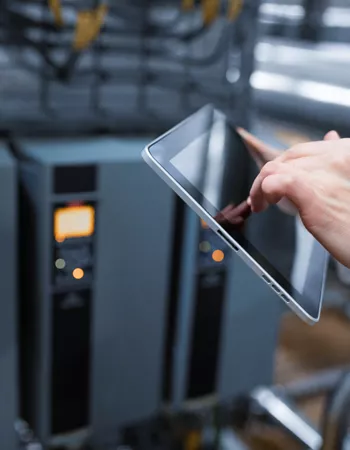
How much does facility management software cost in the UK?
Here at Access, we talk to hundreds of operators who want to know the same thing – what a property management system is going to cost.
The cost of a property management system can vary, depending on a number of influencing factors and the features included. Different providers also offer varying pricing models.
We help guide our customers to work out what kind of system they need, what contributes to the cost, the pros and cons of different systems and how they can budget accordingly.
 10 mins
10 mins
Written by Jen Grenside
What are the typical factors that influence the cost of a property maintenance system?
Here’s our list of the main factors that influence the cost of a property management system - it’s important that you have a good understanding of these factors so you can choose a system that aligns with your business needs.
Scalability – The size of the estate and how many sites you have is a significant factor in determining the cost of a CAFM system. The larger the estate, the more features you may require to achieve full visibility, and therefore the higher the cost.
Functionality – The features and functionalities required in a CAFM system also influence its cost. A basic CAFM system with minimal functionalities will cost less than a comprehensive system with advanced features such as project management, analytics and outsourced virtual property maintenance manager.
Customisation – Customisation of the CAFM system to fit the specific needs of a property can increase the cost. The more customisation required, the more expensive the CAFM system will be.
Integration – The integration of a CAFM system with other existing systems or software can also increase its cost. The more complex the integration requirements, the higher the cost can be.
Support and maintenance – The level of support and maintenance required can also influence the cost of a CAFM system. A comprehensive support package with round-the-clock support and regular maintenance will be more expensive than basic support.
The scale of your business and the scope of functionality needed are going to be huge influencing factors in how much a property maintenance software solution will cost, so consider what exactly you need while you’re shortlisting providers and consider if the cost is justified to obtain the range of functionality the business will ultimately benefit from.
Common pricing models for CAFM software – what will you get for your money?
When it comes to facilities management software, there is no one-size-fits-all pricing model. Various approaches exist, including module-based pricing, square footage-based pricing, user license-based pricing, transaction-based pricing and site-based pricing. Understanding these models is crucial for making an informed decision about the best fit for your organisation.
Let's take a closer look at some of the most common pricing models and who can benefit from them:
Cost per user
The cost per user pricing model is determined by the number of users who need access to the CAFM system and varies depending on the type of license purchased. There are two common licensing models that dictate user access and utilisation of the software:
Named user license
With a named user license, each individual user is assigned a unique license and login credentials. This means that only one specific user can use the CAFM system at a time using their assigned license. Named user licenses are tied to the user's identity, allowing personalised access and tracking of their activities within the software. This licensing model is preferred when individual accountability is required, ensuring exclusive access for each user.
Concurrent user license
In contrast to named user licenses, concurrent user licenses focus on the number of users accessing the CAFM system simultaneously, rather than assigning licenses to specific individuals.
Under a concurrent user license model, a defined number of licenses are purchased, which can be shared among multiple users. For example, if there are ten concurrent user licenses, up to ten users can access the CAFM system simultaneously. Once a user logs out or finishes their session, the license becomes available for another user to access. Concurrent user licenses are commonly used when the number of users exceeds the number of licenses, and not all users require continuous access to the system.
While typically limited to FM/Estate/Property teams, some providers also grant limited access to all employees, enabling them to raise call-out requests for maintenance. However, these requests still need approval from the relevant teams before being scheduled.
This pricing model is well-suited for small businesses that require a limited number of individuals to access the system.
Cost per site
The cost per site model is based on the number of individual facilities or sites within your business. With this pricing model, the cost remains fixed, regardless of the number of users or contractors you have. It provides access to multiple modules, offering an all-in-one solution that can help control costs. This is the model that we use for our Access Maintain CAFM solution.
Here’s how a tiered pricing structure could be worked out, where the more sites you have, the cheaper it is per site, but your total cost is higher.
For example, an operator with five sites may be charged around £1,000 per site, per year (totalling around £5,000), whereas an operator with 10 sites may be charged around £900 per site, per year (totalling around £9,000) and an operator with 20 sites may be charged around £800 per site, per year (totalling around £16,000).
This pricing model is typically suitable for mid-to-large sized operators who require an off-the-shelf CAFM solution, including modules such as reactive and planned maintenance management, asset tracking, contractor management and reporting.
Cost per module
The cost per module pricing model is based on the number of modules or features the business requires to manage facilities maintenance across their estate. Each module has a specific price, and there can be an unlimited number of sites. Examples of providers that offer this type of CAFM model include MRI Software and Bellrock Concerto.
This model allows businesses to selectively invest in modules that are of the highest priority and add further modules over time. However, it is important to plan ahead, as selecting multiple modules in the long run may be more expensive than opting for an all-in-one solution initially.
Here's an example of how this pricing model might look; an operator with hundreds of sites, might want to focus on three core modules, for example:
- ‘Asset management’ at £15k
- ‘Helpdesk module’ another £15k
- ‘Contractor module’ for another £15k.
The basic rule of thumb in the market is that implementation of a modular system will cost the same as the software costs.
This pricing model is typically suitable for large enterprises with numerous sites across their estate. It's worth noting that there may be additional charges for licenses to access the system (see Named User License and Concurrent User License above), so it's essential to verify this with potential suppliers and factor it into the overall cost.
It is important to note that the cost of facilities management software is just one factor to consider when evaluating solutions. Other factors, such as ease of use, scalability, security and customer support, should also be taken into account when making a decision.
It is recommended to research and compare different facilities management software providers and pricing models to find a solution that best meets your needs and budget.
What features does it have as standard?
A CAFM solution enables you to monitor all maintenance activities and their costs in real-time as well as obtain an overview of completed work and the status of any required statutory maintenance, helping you to effectively manage your compliance obligations. Additionally, by automating the entire workflow, you can reduce administrative work, control costs, and expedite repairs.
So, what features and functions should you expect in a CAFM solution? You’ll usually find some features appear consistently across different providers while others may come at an additional cost.
Here is a list of some of the basic tools and features you can expect a CAFM solution to offer:
Asset management – Helps to track and maintain multiple types of assets, such as office equipment or furniture. This includes scheduling maintenance and repairs, managing warranties and service contracts, and tracking asset lifecycles. For hospitality operators, this could include kitchen equipment such as ovens, fryers, refrigerators, and dishwashers, as well as tracking maintenance schedules, service requests, and work orders.
Maintenance management – CAFM solutions provide tools to schedule, manage and track maintenance work, including preventive and reactive maintenance, inspections and repairs.
Contractor management – Facilitates the management of contractors and service providers. This includes tracking their performance, managing contracts and invoices, and ensuring compliance with relevant regulations and standards.
Compliance management – For example, a CAFM solution for restaurants can help manage compliance with food safety regulations, fire safety regulations, and other health and safety standards.
Reporting and analytics – Your chosen solution should provide tools to generate reports and analyse data related to facility and asset performance and maintenance costs.
Mobile access – CAFM solutions often include mobile apps or web interfaces that enable staff to access work orders, maintenance schedules and other information while on the go.
Depending on your operational needs, you may also require some of these additional functions and features:
Integration with other systems – CAFM solutions may integrate with other systems, such as finance and business information reporting tools, to provide a comprehensive view of hospitality operations.
Capital Expenditure project management – Some CAFM solutions can help you manage your property CapEx projects and budgets from discovery to completion, helping to ensure that your projects run to time and schedule, so you can boost ROI.
Room resource booking – Some CAFM suppliers offer this feature which enables users to reserve and manage the usage of rooms and resources within a facility. It helps with scheduling and coordinating the allocation of rooms, equipment and other resources for various purposes, such as meetings, events, training sessions or other activities
Visitor management – This focuses on efficiently and securely managing visitors entering and exiting a facility. It provides tools and processes to streamline the visitor check-in process, enhance security and maintain accurate visitor records
Helpdesk module – To streamline the facility management helpdesk or service desk operations. It’s used for receiving, tracking and resolving facility-related issues and requests from users of the facility.
In house vs outsourced
When it comes to managing facilities maintenance, you have the option to either keep it in-house or opt for an outsourced fully managed property maintenance service. The choice depends on your specific needs and resources.
In-house solution
If you have the necessary resources and expertise within your organisation, an in-house CAFM solution may be the right choice as it allows your own FM/Estates/Property teams to handle facilities maintenance using a CAFM system - which can be tailored to meet your unique requirements.
In-house solutions are suitable for businesses that have dedicated teams capable of effectively managing facilities maintenance and prefer to maintain full control over their operations. This option is often chosen by large enterprises or organisations with extensive property portfolios.
Outsourced fully managed property maintenance service
If you lack the internal resources or expertise to manage facilities maintenance effectively, an outsourced fully managed property maintenance service might be a more suitable option. With this solution, you partner with a third-party provider who assumes responsibility for your facilities maintenance needs. The provider manages all aspects of property maintenance using their own CAFM system. This includes tasks such as scheduling maintenance, tracking work orders and coordinating with contractors.
Outsourcing allows you to leverage the expertise of professionals who specialise in facilities management, freeing up your internal teams to focus on core business activities. This option is particularly beneficial for small to mid-sized businesses that may not have dedicated FM teams or the capacity to handle maintenance operations effectively.
When deciding between an in-house solution and an outsourced fully managed service, consider factors such as your organisation's size, available resources, expertise and the level of control you desire over your facilities maintenance processes. Larger organisations with well-established FM teams may find value in maintaining an in-house solution. On the other hand, smaller businesses that prioritise efficiency and cost-effectiveness may benefit from outsourcing their property maintenance needs to a trusted external provider.
Software updates
The cost and process behind software updates can vary, depending on whether you have an on-premise or SaaS CAFM system. On-premise CAFM systems may involve additional costs for software updates.
Major version upgrades often require purchasing new licenses or paying upgrade fees, which can be substantial depending on the scope of the update.
With cloud-based CAFM systems, version upgrades are typically included in the subscription fees, allowing you to access the latest features and improvements without incurring additional costs.
Ongoing support and service fees
On-premise CAFM systems generally require businesses to manage and maintain the software themselves, including performing updates and patches. This may involve costs associated with internal IT staff or engaging third-party support services for ongoing maintenance and support.
In contrast, cloud-based CAFM systems often include maintenance and support as part of the subscription fees.
Costs of implementation / set up costs
The costs of implementation of a new CAFM software system can vary depending on several factors, including the size and complexity of the business, the specific requirements and functionalities needed, and the chosen deployment model (on-premise or cloud-based).
Perhaps unsurprisingly, on-premise CAFM systems typically require a higher upfront investment in hardware, infrastructure and licenses compared to cloud-based CAFM systems. This is because on-premise systems are installed and maintained on the operators own servers and infrastructure. The initial investment covers the cost of purchasing and deploying the necessary hardware and software licenses. In contrast, cloud based CAFM systems are hosted and maintained by the software provider, eliminating the need for upfront hardware and infrastructure costs.
But then, there are also differences based on the type of pricing model selected and the supplier. Fixed cost solutions that provide out-of-the-box functionality may have lower implementation costs than modular solutions, because they are of a more standardised offering. Modular solutions often involve configuring the software to align with the operators' specific requirements and workflows. This may include defining organisational hierarchies, creating user roles and permissions, configuring modules and workflows, and integrating with other systems. Customisation, if needed, to address unique business needs may incur additional costs depending on the complexity and extent of the customisations required.
How can you determine the ROI of your facilities management software?
If you’re experiencing any of the following business challenges, then investing in a facilities management solution could provide some real return on investment benefits for your business.
Do any of these apply to you?
- We have no visibility on whether jobs are being completed
- We have continual feedback from sites that maintenance issues are not being resolved, despite multiple contractor visits
- We don’t know how long contractors are onsite and what they have done when they are there
- We have no asset (equipment) lists for each of our sites and no way of tracking what we are spending on individual asset maintenance
- We have no accurate view of what we are spending on maintenance until invoices are paid via the finance system – no control
- We don’t know if we are up to date with all our statutory compliance tasks
- We don’t have all compliance certification stored in one place
A facilities maintenance solution could help you to combat all these issues.
Centralised data and information
A CAFM system provides a centralised repository for storing and managing facility-related data and information. It enables easy access to critical information such as floor plans, equipment details, maintenance records and service contracts. Having a single source of truth for facility data promotes transparency, accuracy, and efficient decision.
Streamlined facility operations
CAFM systems streamline various facility management processes, including work order management, preventive maintenance scheduling, asset tracking and resource allocation. Automation and workflow management functionalities within the system help streamline processes, reduce manual effort and improve operational efficiency.
Improved maintenance management
CAFM systems enable operators to proactively manage maintenance activities. They provide tools for tracking and scheduling preventive maintenance tasks, managing work orders and generating maintenance reports. By ensuring regular upkeep of facilities and equipment, operators can enhance asset performance, extend their lifespan and minimise costly downtime.
Real-time reporting and analytics
CAFM systems generate real-time reports and analytics to provide valuable insights into facility performance and maintenance trends. These reports help stakeholders make data-driven decisions, identify areas for improvement and monitor key performance indicators (KPIs) such as energy consumption, maintenance costs and service level compliance.
Improved collaboration and communication
CAFM systems facilitate collaboration and communication among facility management teams, maintenance staff and stakeholders. The system provides a platform for sharing information, assigning tasks and tracking progress. This improves coordination, reduces communication gaps and enhances responsiveness to facility-related issues.
Compliance and regulatory management
CAFM systems assist operators in maintaining compliance with regulations and standards relevant to facility management. The system can help track compliance requirements, schedule inspections and generate reports for auditing purposes. This ensures that facilities meet safety, environmental and operational compliance standards.
Cost savings and ROI
By optimising facility operations, automating processes, and improving maintenance management, CAFM systems can lead to cost savings for operators. Reduced downtime, efficient maintenance practices, and accurate asset tracking contribute to cost savings and a positive return on investment (ROI) over time.
Overall, implementing a CAFM system helps operators streamline facility management processes, improve operational efficiency, enhance maintenance practices, and make informed decisions based on real-time data and insights. These benefits contribute to better facility performance, increased productivity, cost savings, and improved guest experiences.
How pricing of Access Maintain works
As mentioned earlier in this article, Access Maintain is priced by site. The simplicity of a cost per site model enables as many users as necessary and is entirely scalable as the estate size grows.
Our solution starts from £65 per site/per month for the out-of-the-box solution and this can be influenced by the total number of sites you have and the contract length. Furthermore, we also have additional modules to manage both project work and equipment ordering, as well as the management of an in-house maintenance team.
If you’re interested in a personalised cost summary for your business, get in touch with a member of the team.
Book a personal demo
Schedule a time to find out how you can get effective oversight and control across all your sites.
Get effective oversight and control across all your sites with our property maintenance system
Related reading
View our resources to support you with facility management






